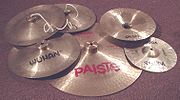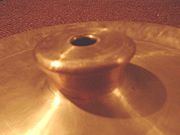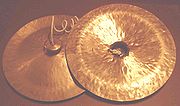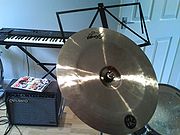
China cymbal
Encyclopedia

Music
Music is an art form whose medium is sound and silence. Its common elements are pitch , rhythm , dynamics, and the sonic qualities of timbre and texture...
, china type cymbals are cymbal
Cymbal
Cymbals are a common percussion instrument. Cymbals consist of thin, normally round plates of various alloys; see cymbal making for a discussion of their manufacture. The greater majority of cymbals are of indefinite pitch, although small disc-shaped cymbals based on ancient designs sound a...
s manufactured to produce a dark, crisp, trashy, and explosive tone. It is for this reason that they have been nicknamed "trash cymbals." Their origins can be traced back to the gong
Gong
A gong is an East and South East Asian musical percussion instrument that takes the form of a flat metal disc which is hit with a mallet....
in both sound and shape, and thus they are given their name "china".
China type cymbals typically have a bell
Bell (instrument)
A bell is a simple sound-making device. The bell is a percussion instrument and an idiophone. Its form is usually a hollow, cup-shaped object, which resonates upon being struck...
that is cylindrical or shaped like a truncated cone with its base the top of the bell, an outer rim that is turned up in the reverse direction to the main bow of the cymbal, little or no taper (change in thickness) from bell to rim, and an area including the inside of the bell that is unpolished. However some china type cymbals have only some or in some cases none of these distinguishing characteristics. The distinguishing feature of a china type cymbal is the one that is hardest to define: its sound. China cymbals are those whose sounds are derived from the Chinese, rather than the Turkish, tradition of cymbal making.
There are two or three tonal families of cymbals: Turkish, Chinese, and some would say European, although others would include the European family of tones as a development of the Turkish sounds. The best Turkish (and European) cymbals have a rich, swelling tone that some describe as "sweet". To western ears, the best china types have an abrasive, cutting sound that is described by western drummers as "trashy".

Swish cymbal
The swish cymbal and the pang cymbal are exotic ride cymbals originally developed and named as part of the collaboration between Gene Krupa and the Avedis Zildjian Company...
cymbals have some characteristics of china types, and some characteristics of traditional Turkish cymbals. On the other hand, the Sabian
Sabian (company)
Sabian is a Canadian cymbal designer and manufacturer. It is a leading manufacturer of cymbals along with other top companies such as Zildjian, Paiste, and Meinl.-History:...
rocktagon cymbals and some Ufip models are considered china types while having none of the physical characteristics of the normal china type, while the Paiste
Paiste
Paiste, a Swiss manufacturer and designer, is the world's third largest manufacturer of cymbals, gongs, and metal percussion. Paiste is an Estonian/Finnish word which means "shine"...
crystal crash is considered a European cymbal despite its squarish bell.
Cymbal making in China is claimed to predate the development of the art anywhere else in the world. The most universally acclaimed cymbal alloy
Cymbal alloys
Cymbals are made from four main alloys, all of them copper-based. These are: bell bronze, malleable bronze, brass and nickel silver.-Bell bronze:Bell bronze, also known as bell metal, is the traditional alloy used for fine cymbals, many gongs and, as the name suggests, bells.It is normally stated...
, bell bronze, appears to have been independently developed in China. Today in China a wide range of cymbals are manufactured of both traditional and imported patterns. Traditional Chinese types with distinctive names and sounds include chung, jing and water cymbals and many other types. In Western music these are all referred to as china type cymbals.

Clash cymbals
Clash cymbals or hand cymbals are cymbals played in identical pairs by holding one cymbal in each hand and striking the two together.-Terminology:The technical term clash cymbal is rarely used...
. Those of 12" or smaller are normally referred to in Western music as china splash cymbals. When used in a drum kit
Drum kit
A drum kit is a collection of drums, cymbals and often other percussion instruments, such as cowbells, wood blocks, triangles, chimes, or tambourines, arranged for convenient playing by a single person ....
, they are regarded as effects cymbal
Effects cymbal
An effects cymbal is a cymbal used in a drum kit for a special effect or accent. Effects cymbals include splash cymbals, china cymbals and many other less common types....
s and are used to give colour and variety.
In a drum kit, china type cymbals are sometimes mounted bell up, similarly to other cymbals, but more often bell down. When mounted bell down, the upturned rim becomes a downturned rim, allowing a normal stick technique to be used for both ride and crash patterns. This assumes that the bell is formed in the typical direction; Some china type cymbals (e.q. the Paiste
Paiste
Paiste, a Swiss manufacturer and designer, is the world's third largest manufacturer of cymbals, gongs, and metal percussion. Paiste is an Estonian/Finnish word which means "shine"...
2002 Novo china) have an inverted bell
Inverted bell
The inverted bell is a metaphorical name for geometric shape that resembles a bell upside down.In architecture, the term is applied, e.g., to describe the shape of the capitals of Corinthian columns....
and an upturned rim, and so must be mounted bell up to achieve this downwards rim orientation.

Pang and swish
The swish and pang are specific sounds within the enormous range of china cymbals, developed as exotic ride cymbals but also used as crashes at higher volumes.China splash
12" or smaller.Sabian refer to both their 12" and 14" nova chinese models as mini chinese.
Rocktagon
A Sabian exclusive, an octagonal cymbal with a sound midway between a crash and a china. The cymbal is manufactured as round and cut to shape after all-over lathing. Available in 16", 18", and as the 10" Rocktagon splash.Sticking Techniques
There are numerous methods of playing a china Cymbal, which can vary depending on the genre of music played.For example, in modern metal music, players generally tend to play using the shoulder of the stick rather than the tip for a more "trashy" sound. In other genres such as jazz (which may use less hammered cymbals for a lighter and less distorted effect) the drummer may play with the tip for more of a "sizzle" sound.

